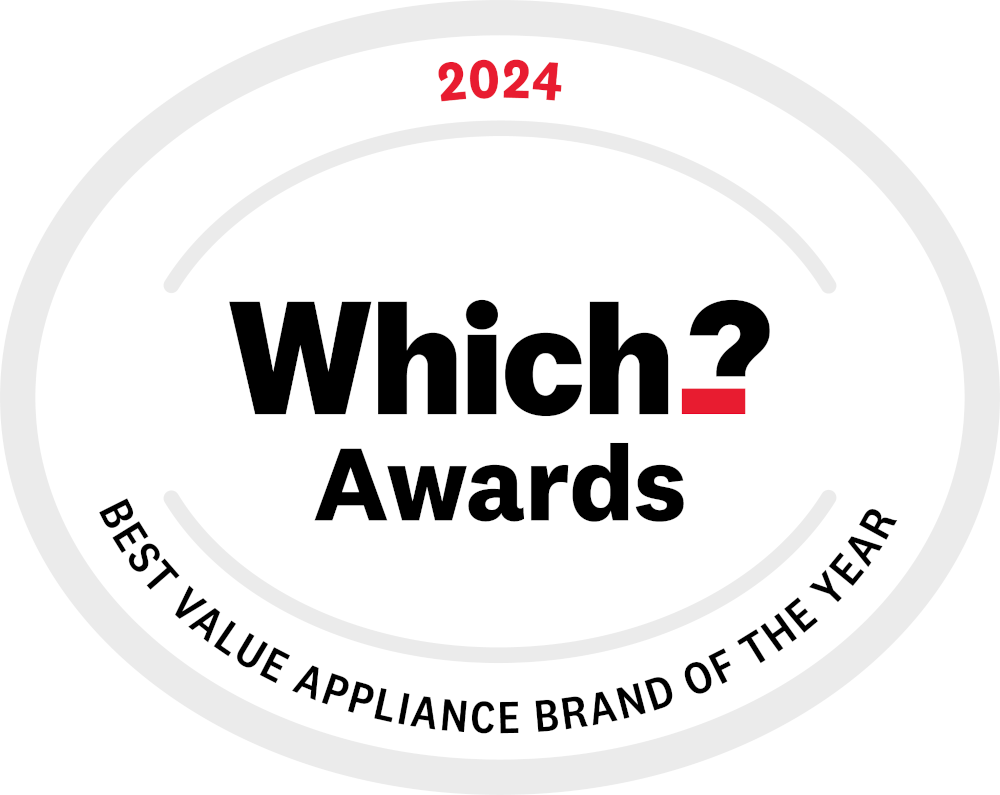How Much Does a Tumble Dryer Cost to Run?
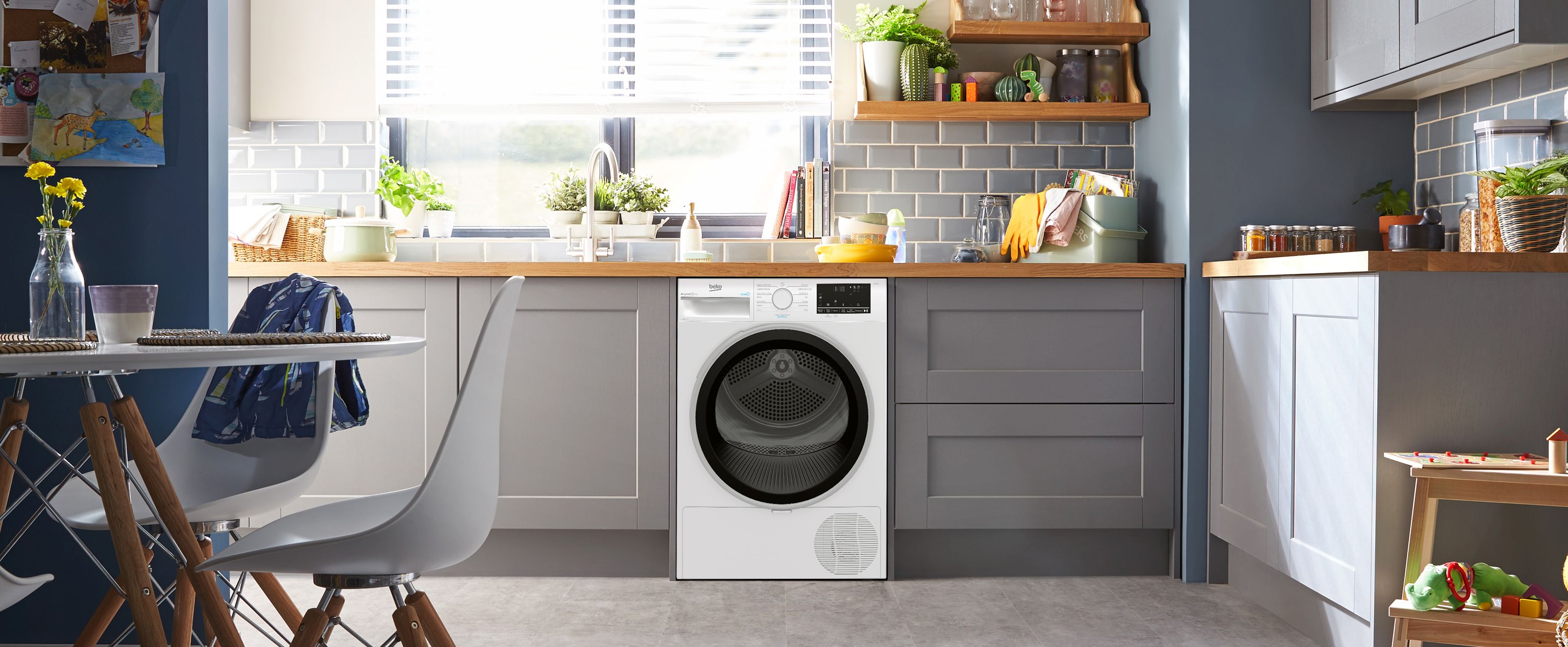
Understanding the cost of running a tumble dryer is essential for UK homeowners who are conscious of their energy bills.
The running costs of a tumble dryer can vary significantly depending on the type of dryer, how frequently you use it, and the energy tariffs in your area. This guide will look at the different types of tumble dryers and their associated costs, so that you can make an informed decision about which model is best suited for your household. We will also explore practical tips to help you reduce running costs.
Do Condenser Tumble Dryers Need Ventilation?
One of the main advantages of a condenser tumble dryer is that it doesn’t require external ventilation. This feature opens up more options for placement around your home, as you won’t need to worry about positioning the dryer near an external wall for venting purposes. Instead, the dryer collects moisture in a tank or directs it into a drain, allowing it to be placed in interior rooms such as utility spaces or bathrooms. However, despite the lack of need for external venting, it’s important to ensure the room where the dryer is installed has good airflow to prevent condensation and maintain efficiency.
Understanding tumble dryer running costs
Several key factors determine the cost of running a tumble dryer. More energy-efficient models, such as heat pump tumble dryers, which recycle warm air within the dryer, use considerably less electricity compared to vented or standard condenser dryers, leading to lower running costs.
How often you use your tumble dryer also plays a significant role in your overall costs. The more frequently you run it, the more electricity you consume, leading to higher bills.
Using a lower temperature to dry the load, heat pump tumble dryers are the most energy-efficient tumble dryers on the market and can save over £130 a year in running costs when compared to a standard condenser dryer.[1] For more information on the different types of tumble dryers, please click here.
On average, a condenser tumble dryer costs £668 to run per year[2]. In comparison, a heat pump tumble dryer costs £227 to run on average per year.[3] To figure out the precise cost of your tumble dryer, you will need to check the kWh usage of your dryer and multiply this by your tariff costs, along with how often you use your appliance. If you own a Beko tumble dryer, the kWh usage of your appliance can be found on our website. To find this information, simply insert your model number into the search bar on our site and click through to your product’s page. Once on this page, scroll down to the product specification section where the consumption value can be found.
Are tumble dryers expensive to run?
Tumble dryers can be costly to run, especially older models or if used frequently. As tumble dryers age, they become less efficient due to wear and tear, causing the machine to work harder and use more energy to achieve the same results. Furthermore, older tumble dryers generate and release a lot of heat to dry clothes quickly compared to newer models.
Types of tumble dryers and their running costs
There are three main types of tumble dryers: vented, condenser, and heat pump. Each type has different energy consumption levels and associated running costs. Choosing the best one for your household will depend on your needs and your budget.
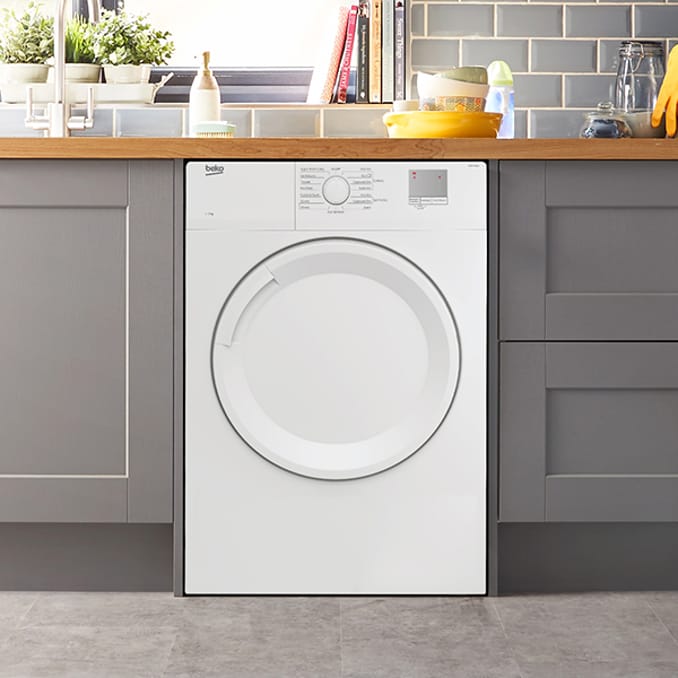
Vented tumble dryers
Vented tumble dryers expel hot, moist air through a vent or duct to the outside. These models are less energy-efficient. Vented dryers may be cheaper upfront but can be more expensive to run over time.
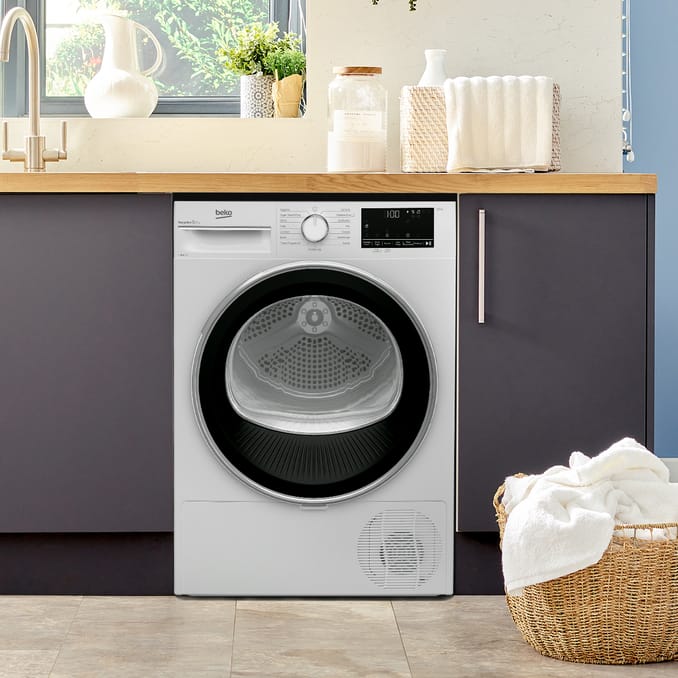
Condenser tumble dryers
Condenser tumble dryers collect moisture in a water tank rather than venting it outside. On average, a condenser tumble dryer costs £668 to run per year.[2] These models offer flexibility in placement since they don't require external venting, but they can be more expensive to operate.
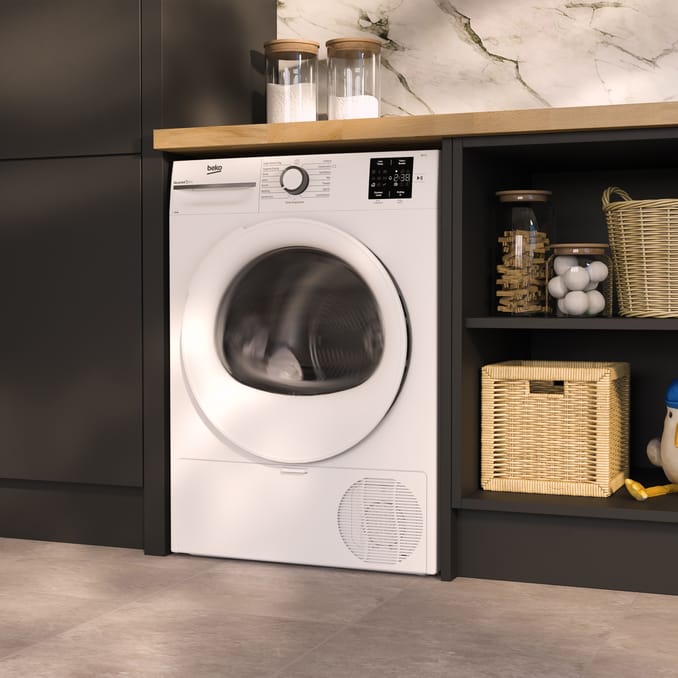
Heat pump tumble dryers
Heat pump tumble dryers are condenser type dryers but they use advanced technology to recycle warm air, making them the most energy-efficient option. Heat pump tumble dryer costs £227 to run on average per year.[3] This makes them the most cost-effective choice in the long run. Additionally, their lower operating temperatures are gentler on clothes, extending their lifespan.
Tips to reduce tumble dryer running costs
Reducing tumble dryer running costs is possible with a few practical strategies. From choosing an energy-efficient tumble dryer and running full loads to maximise energy efficiency to regularly cleaning the lint filter to ensure optimal airflow and using lower heat settings, you can significantly reduce your energy consumption and your bill.
Choose an energy-efficient model
Investing in an energy-efficient model, such as a heat pump dryer, can lead to significant long-term savings on your energy bills. Although these models may have a higher upfront cost, the reduced running costs quickly make up for it.
Consider high-performance heat pump dryers such as the 9kg Heat Pump Tumble Dryer, with an annual energy consumption of 194.4 kWh, sensor programmes that monitor moisture, and Beko's SteamCure. The 8kg Heat Pump Tumble Dryer with RapiDry is another excellent option, with an annual energy consumption of 236.0 kWh and the RapiDry function that allows you to efficiently dry up to 5kg of laundry in just one hour, saving you time, energy, and costly bills.
Optimise your drying cycles
At Beko, we’ve incorporated sensor drying programmes into our models which identify moisture levels in the drum and stop the cycle when clothes reach optimal dryness. This helps avoid over-drying and cuts down on your energy bills. Additionally, using high spin cycles on your washing machine will reduce the moisture in your clothes before they go into the dryer, shortening drying time and, most importantly, reducing energy consumption.
Also, consider drying during off-peak hours. If your energy plan offers lower rates during certain times, schedule your drying cycles accordingly. These practices can lead to substantial savings over time
The environmental impact of tumble dryers
Tumble dryers are among the most energy-intensive household appliances, with vented and condenser models using more than 5 kWh per cycle and heat pump tumble dryers consuming around 2kWh, which adds up significantly over time. This high energy consumption not only increases utility bills but also puts a strain on power generation resources, many of which still rely on fossil fuels.
When these fuels are burned to produce electricity, they release greenhouse gases such as carbon dioxide (CO2) into the atmosphere, contributing to climate change and leading to global warming.
Air drying is the preferred solution when drying clothes, particularly if you have access to outdoor space. However, if outdoor drying isn't an option, using a tumble dryer can be beneficial in preventing the moisture buildup that indoor air drying may cause. Excess moisture from drying clothes indoors can increase the risk of mould formation and negatively affect indoor air quality. A tumble dryer helps mitigate these issues while providing a convenient and efficient drying solution, especially in homes without adequate ventilation or outdoor drying areas.
Reducing your energy consumption
Opting for energy-efficient tumble dryers, particularly heat pump models, can significantly reduce your electricity consumption. These dryers use advanced technology to recycle heat, consuming far less energy compared to vented or traditional condenser models. As a result, they lead to lower energy bills.
To further enhance efficiency a, consider adopting e practices such as drying full loads, selecting lower heat settings, and regularly cleaning the lint filter. These simple steps can help maintain your dryer’s performance while promoting energy savings.
FAQs
What type of tumble dryer is the cheapest to run?
Heat pump tumble dryers are the cheapest to run due to their advanced energy-efficient technology. Unlike vented or condenser dryers, heat pump dryers recycle warm air within the machine, significantly reducing the amount of energy needed to dry your clothes. Although they may have a higher initial purchase price, their low energy consumption translates into substantial savings on your electricity bills over time. In fact, they can use up to 50% less electricity than traditional models, making them the most cost-effective option for long-term use.
How can I make my tumble dryer more energy-efficient?
You can make your tumble dryer more energy-efficient by adopting a few simple practices. First, perform regular maintenance, such as cleaning the lint filter after every use and checking the condenser or heat pump unit periodically. This ensures that your dryer operates efficiently without unnecessary energy waste. Second, always dry full, but not overloaded, loads whenever possible. Use a high spin speed during the washing cycle to extract more moisture from your clothes before they go into the dryer. Lastly, use eco settings or lower heat options, which reduce energy consumption while still effectively drying your clothes. These small adjustments can lead to significant savings on your energy bills
What should I look for when buying an energy-efficient tumble dryer?
When buying an energy-efficient tumble dryer, prioritise models with heat pump technology and a high energy rating (A++ or A+++). Look for sensor drying features that stop the cycle when clothes are dry, saving energy and preventing over-drying. Lastly, choose the right load capacity to minimise the need for multiple cycles, ensuring optimal energy efficiency for your household.
Can I reduce drying time without increasing energy costs?
You can reduce drying time without significantly increasing energy costs by following a few tips:
- Spin dry first: Use a high spin speed on your washing machine to remove as much water as possible before placing clothes in the dryer.
- Separate heavy items: Dry heavier items separately from lighter fabrics to ensure even drying and reduce cycle time.
- Use dryer balls: Adding wool or rubber dryer balls can help separate clothes and improve airflow, which can speed up drying time.
At Beko, we’ve developed the RapiDry™ feature for our heat pump tumble dryers, designed to maximise energy efficiency while offering faster drying options for when you’re in a hurry. This innovative technology combines the energy-efficient heat pump system with a conventional heater, providing quicker drying times. While these faster drying settings are less energy-efficient compared to standard programmes, they are still more efficient than traditional condenser models, helping you save energy without sacrificing convenience. This versatility makes it easier to tailor drying times based on your needs.
To discover the ideal solution for your needs, explore Beko’s range of energy-efficient tumble dryers and streamline your household with a smarter choice.
Sources
[1] https://www.amdea.org.uk/campaigns/know-watts-what/household-hacks/
[2] Uses the YourEko tool calculation that compares the annual energy consumption of all condenser dryers in the market, based on the Cotton cupboard dry programme (used by the EU Energy Label Standard) and 260 cycles per year. Energy tariff of 34p kWh. Date of calculation: November 2022.
[3] Uses the YourEko tool calculation that compares the annual energy consumption of all heat pump dryers in the market, based on the Cotton cupboard dry programme (used by the EU Energy Label Standard) and 260 cycles per year. Energy tariff of 34p kWh. Date of calculation: November 2022.
Did we answer your question?
We are so sorry we were unable to answer your question. You might be able to find the answer you are looking for in the ‘Related Questions’ below. If your query is still unanswered, please head over to our Contact Us page for further assistance.
Search FAQ’s
Search or browse our frequently asked questions to find the answer to your query.

